How is Turkey planning to rebuild after a devastating earthquake?
21 March 2023
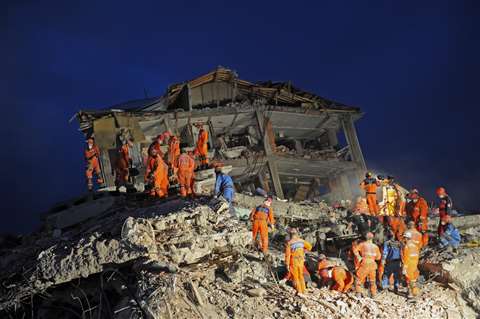 Houses damaged by the earthquake in Elazig Turkey (by Mehmet via Adobe Stock)
Houses damaged by the earthquake in Elazig Turkey (by Mehmet via Adobe Stock)
It’s now over a month since two earthquakes in rapid succession devastated parts of Turkey and neighbouring Syria.
And yet the scale of the disaster is still difficult to truly comprehend. On a human level, the death toll is estimated at around 51,000 people, of which around 45,000 were in Turkey. Meanwhile, millions more have been left uprooted across a 200-mile-long path of destruction.
But the earthquakes – a magnitude 7.8 quake 23 miles west-northwest of Gaziantep in Turkey on 6 February, followed by a magnitude 7.7 earthquake later in the day 59 miles north of the first – have also destroyed hundreds of thousands of buildings.
In fact, recent estimates have put the number of buildings either destroyed or severely damaged at more than 200,000.
Now that the rescue efforts are over, the need to rebuild housing and infrastructure for all the people who have been displaced is pressing. And it is likely to cost tens of billions of dollars.
Facing a general election this year, Turkish president Recep Tayyip Erdoğan’s government was swift to launch an investigation into building contractors after tens of thousands of buildings collapsed. So far, nearly 200 people have been arrested as a result of those investigations.
Meanwhile, at the start of this month, Erdoğan pledged, “We will build better buildings in the place of those which collapsed. We will win hearts and we will unroll a new future in front of our people.”
Ambitious targets
The government has promised to build a total of 488,000 homes across the region affected by the earthquake within a year, in a highly ambitious programme.
Taking charge of the effort is the Ministry of Environment, Urbanization and Climate Change, led by environment and urbanisation minister Murat Kurum.
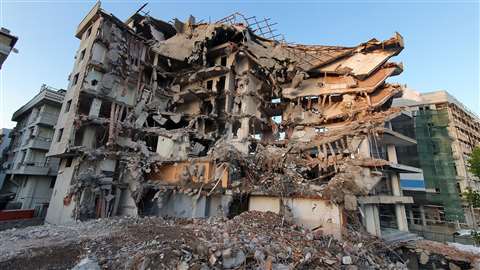 A destroyed building in the Turkis province of Kahramanmaras (Image: Hasan via Adobe Stock)
A destroyed building in the Turkis province of Kahramanmaras (Image: Hasan via Adobe Stock)
Meanwhile, Turkey’s housing authority TOKİ is the mandated agency for the reconstruction effort in the affected cities.
It has been reported that over 133,000 houses across 10 provinces built by TOKİ, which undertakes public housing projects for low-income citizens, did not suffer any structural damage.
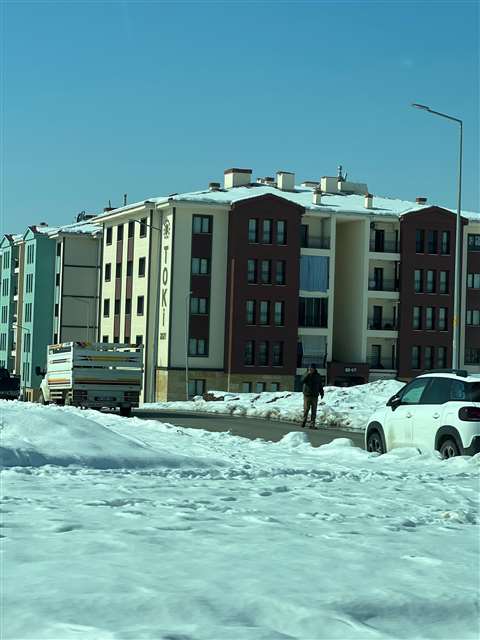 A TOKİ building stands undamaged in Malatya following the earthquakes (Image: Mevlüt Kahraman)
A TOKİ building stands undamaged in Malatya following the earthquakes (Image: Mevlüt Kahraman)
Mevlüt Kahraman is director of construction and technical works at Bilkent University at Ankara. While Ankara itself was largely unaffected by the quakes, Kahraman visited Malatya five days after they occurred to assess the site of a school construction he is overseeing there. He also travelled on to Adıyaman to assess the damage there, which he described as “terrible”.
“My observation of the region is that most of the buildings that have damage or collapsed had very few shear walls. The construction quality was mostly low,” he says.
But he agrees that TOKİ’s buildings are generally resistant to earthquakes.
That is because they are built using a tunnel formwork system, which allows them to perform well in areas prone to high seismic risk.
The multi-storey reinforced concrete buildings rely on a high number of shear walls to resist lateral loads and carry vertical loads.
It is this method of construction that the Turkish government has pledged to employ in the reconstruction of homes, coupled with geological and ground survey studies.
Kahraman asserts that tunnel form construction is a proven technology and one that Turkey’s construction industry is already familiar with, having used it for 40 years.
Meanwhile Mike Mieler, senior risk and resilience engineer at Arup recommended that construction companies move away from unreinforced masonry infill walls, which are commonly used in reinforced concrete framed structures in Turkey in interior and exterior partition walls.
In a LinkedIn post, Mieler, who is currently assessing damage in the area, noted that such walls often crack and crumble in earthquake and pose a serious risk to safety.
While acknowledging that the technique won’t go away soon, some in Turkey’s construction industry have already taken note, with the developers of a base-isolated hospital opting to replace infill walls with steel frame partitions.
Damage beyond experts’ expectations
Facing re-election, it’s understandable that Erdoğan would want to rebuild quickly. But the scale of the challenge is huge given the extensive damage.
Dr Mete Basar Baypinar is assistant professor in the department of urban and regional planning at Istanbul University. He and colleagues from the university visited the southern part of the disaster region, including the cities of Antakya and Iskenderun, in late February. They experienced a third large earthquake on 20 February while in the region and saw first hand the effect that it had on already-damaged buildings.
“In Antakya, very large areas with multi-floor apartment buildings were completely destroyed or heavily damaged,” says Baypinar.
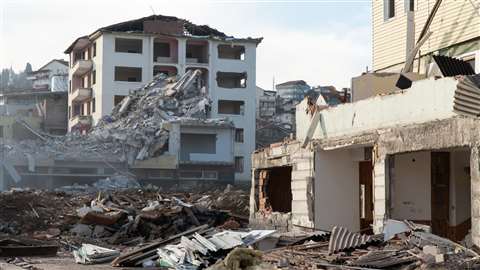 Image: Mete Caner Arican via Adobe Stock
Image: Mete Caner Arican via Adobe Stock
“While major arterial roads were opened, secondary roads were still clogged with debris. For a few kilometres, I saw between two and five excavators per 1,000 sq m along main roads removing the debris, while many more also were working in between arterial roads.”
Baypinar has previously led a Disaster and Climate Change Resilience and Urban Transformation Capacity Development project for the World Bank, focusing on the area. He has also been part of the university’s ongoing work on urban resilience planning in Osmaniye. “I already knew the area was quite vulnerable. But the devastation for example in Kahramanmaraş, far exceeded my expectations,” he says.
“The sheer number of housing projects promised by government as well as some opposition parties do not really seem to be possible, given bottlenecks regarding construction materials, particularly aggregates,” he says.
And he notes that high prices due to energy costs and logistical problems in the earthquake area add to the challenge.
Careful planning required
Kahraman emphasises the need for careful planning ahead of reconstruction.
“All construction disciplines – city planners, landscape architects, interior architects and engineers – need to be involved. Speed is important but planning should be even more so,” he says.
Baypinar points out that not only will many building themselves will require reconstruction, but infrastructure like the drinking water and wastewater systems will probably have to be completely overhauled.
Building densities, land use and transport connections are all likely to change as a result of the reconstruction and that means that power networks will also have to be rebuilt. And authorities will need to consider safe power storage options in case of future disasters because relief efforts were hampered by a lack of energy after February’s earthquakes.
He also recommends changes to the region’s transport systems which historically have run on the fault lines. “The resilience of transport infrastructure and terminals remains a key issues for this resource-rich and competitive industrial and agricultural region,” Baypinar says.
“In general, the region lacked strong mass transportation systems and mostly relied on ageing bus and minibus fleets. We had been working on more sustainable and accessible mass transport systems before the disaster and were trying to secure international financial support.
“I believe that mass transport systems and accompanying shared systems like car-pooling and e-scooters could help revive the economies in these cities more quickly.”
Retrofitting and zoning
Official assessments of buildings in the earthquake-hit region have suggested that up to 232,000 buildings – around 30% of the existing building stock – will have to be demolished.
But many more will need retrofitting and reinforcements.
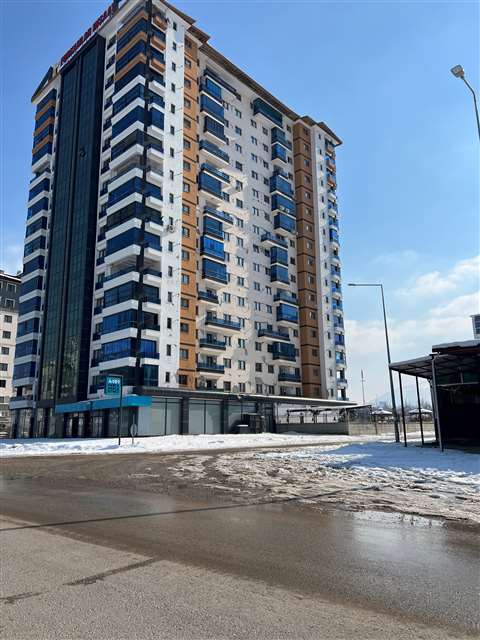 A 15-storey building with 60 units in Malatya, which has suffered medium to heavy damage. It is likely to be demolished but experts advocate retrofitting where appropriate. (Image: Mevlüt Kahraman)
A 15-storey building with 60 units in Malatya, which has suffered medium to heavy damage. It is likely to be demolished but experts advocate retrofitting where appropriate. (Image: Mevlüt Kahraman)
Baypinar points out that a good proportion of buildings were probably not completely illegally built but had multiple issues regarding compliance to building codes, as well as dangerous additions or removal of structural components due to adaptation, misuse or lack of adequate maintenance.
“Unfortunately the high rate of informal buildings overall the country puts pressure on governments. Owners and occupiers make multiple additions to enlarge their usage space, either because they cannot afford to buy larger houses, or just because such attempts remain rewarded rather than punished,” says Baypinar.
“Zoning has become weaker and weaker in Turkey, where many units in residential buildings have been converted to discount supermarkets, cafes and other retail units. Many of these activities, which were regarded as “safe” by the Directive for Opening and Licensing of Workplaces, have become deadly as columns were removed from buildings to accommodate them. So, not only has construction been an issue, but managing the buildings and coupling with zoning has become an issue.
“We need a new paradigm regarding urban transformation, integrating zoning, building life cycle management and sustainable urban development, which, has to also aim to decrease informal activities and enhance disaster and climate resilience.”
Kahraman recommends adding new shear walls to existing buildings, depending on their condition. He also advocates column jacketing combined with concrete or fibre composite materials around damaged columns where appropriate. And he suggests adding fibre composite materials to strengthen unreinforced infill walls in existing buildings too.
“If the building is suitable, we can also use steel elements combined with carbon fibre materials. But some government agencies are not warm to the idea of retrofitting and prefer new construction,” he adds.
“But the number of buildings which need to be reconstructed is too large and we don’t have an infinite budget. In Malatya, a city I know better than others, there are a lot of buildings that have suffered light or medium damage that can easily be retrofitted, which can reduce the total reconstruction cost. New construction in Turkey costs about $500 per sq m on average, whereas retrofitting costs about $100 per sq m.”
Costs and funding
World Bank estimates at the end of February put the estimated cost of direct physical damage in Turkey at US$34.2 billion.
But it also acknowledged that the final recovery and construction cost will be much larger – potentially twice as large.
Direct damage to residential buildings account for 53% of that cost ($18 billion), with 28% ($9.7 billion) in non-residential buildings. Infrastructure suffered another $6.4 billion in damage.
The World Bank has announced an initial package of $1.78 billion for relief and recovery efforts.
Baypinar expects central and municipal governments to be able to raise more funds from the World Bank, European Union, the EU Solidarity Fund and other sources.
But he expects that the country will need funds not only to rebuild buildings and infrastructure but to ramp up production and transportation of construction materials.
And he warns against rushed projects in the aftermath of the earthquake. “Most experts are busy now in damage assessment or assessment of vulnerability of present buildings in larger cities, so there is very little capacity left for adequate construction quality controls at the moment.”
He concludes, “I believe that if Turkey can demonstrate that it can handle the process of post-disaster recovery and development planning, apply risk-based land use planning and zoning management, introduce stricter codes for quality controls during construction processes, apply a thorough check of present building stocks, and develop emergency action plans, more and more funds would easily flow here.
“We also have to find innovative and creative ways to decrease costs arising from materials and bottlenecks in professional services. For example, the introduction of hybrid buildings where wood or other materials are used modularly could be a good short term solution perhaps. But these have to be studied rapidly under given market conditions.”
STAY CONNECTED



Receive the information you need when you need it through our world-leading magazines, newsletters and daily briefings.
CONNECT WITH THE TEAM









